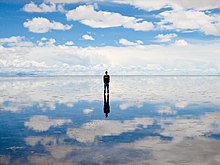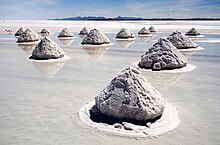Salar de Uyuni
| Salar de Uyuni | ||
|---|---|---|

|
||
| Geographical location |
|
|
| Tributaries | Río Grande de Lípez | |
| Drain | no | |
| Islands | Isla del Pescado , Isla Incahuasi | |
| Places on the shore | Uyuni | |
| Data | ||
| Coordinates | 20 ° 18 ′ S , 67 ° 36 ′ W | |
|
|
||
| Altitude above sea level | 3653 m | |
| surface | 10,582 km² | |
| length | 140 km | |
| width | 110 km | |
| Maximum depth | at least 220 m | |
|
particularities |
Largest salt pan on earth, dried out 10,000 years ago |
|


The Salar de Uyuni (also Salar de Tunupa ) in Bolivia is the largest salt pan on earth with more than 10,000 square kilometers . The salt crust was formed over 10,000 years ago when the Paleo Tauca dried up .
Geographical location
The Salar de Uyuni is located in southwest Bolivia at an altitude of 3653 m and is one of the landscapes of the Altiplano .
description
With an area of 10,582 km², the basin has a larger area than, for example, Lower Bavaria . It is also larger than Lake Onega , Europe's second largest lake.
The brine below the surface extends "up to 72 meters" or even "at least 121 meters" into the depth.
With glaring brightness during the day and very cold nights, the Salar de Uyuni looks like a frozen lake on the outside. It is practically free of any kind of living thing, but breeding ground for some flamingo species that are only found in South America .
During the rainy season, the salt crust can be locally covered with several decimeters of water; The Salar is dry from around the end of June to the beginning of the rainy season in early December. With the exception of the muddy bank zones and individual water eyes (ojos) , the up to 30 meter thick salt crust can then be driven over by buses and trucks.
During the Saltpetre War , the nearby city of Uyuni was a garrison town; today it is the starting point for tourist excursions in the area.
In the middle of the salt pan, about 80 kilometers from Uyuni, is Isla Incahuasi ( Quechua for House of the Inca ), which is known for its many meter-high column cacti, some of which are more than 1200 years old. In the dry season it can be reached by bike via Colchani, and with up to 20 centimeters of water cover also by off-road vehicle.
Another island is the Isla del Pescado .
Salt extraction
The amount of salt in the Salar de Uyuni is estimated at around ten billion tons. Every year around 25,000 tons of this are mined and transported to the cities.
Lithium and potassium deposits
The Salar de Uyuni is home to one of the world's largest lithium deposits . According to the US Geological Survey , lithium is estimated to be around 5.4 million tons. Since lithium-ion batteries - due to their energy density , high cell voltage and low self-discharge - are used in many electronic and electrical devices, the element lithium is now a valuable raw material for the automotive industry with high growth potential.
Bolivia's President Evo Morales commissioned the project for a pilot factory to extract lithium from the Salar de Uyuni in 2007. By decree of April 1, 2008, the industrialization of the salar's resources was given national priority and the state mining company COMIBOL received an additional department for the exploitation of the salt basin, with a budget of 5.7 million US dollars. Construction of the pilot factory in Llipi Loma in the canton of Río Grande began in May 2008. The pilot project also included years of development of technologies for the extraction of lithium carbonate , as the weather conditions and the nature of the brine of the salar do not favor other common methods. The first 16 and 68 tons of lithium carbonate were processed in 2016/2017. The new production facility to be built should produce 15,000 tons per year: On August 15, 2015, the Thuringian company K-UTEC AG Salt Technologies received an order worth 4.5 million euros for the planning of the large industrial conveyor system in the presence of President Evo Morales . The Bolivian government plans to invest at least $ 600 million in Uyuni. The Bolivian President's goal is to exploit the entire value chain in Bolivia, including processing it into the end product, i.e. avoiding the mere export of raw materials . On October 5, 2018, Yacimientos de Litio Bolivianos founded a joint venture with the German consortium to commercialize the Bolivian lithium reserves. A fertilizer factory built by a Chinese company to produce potassium chloride supplements lithium production and uses its brine.
The brine in the salar has an average density of 1.22 g / cm 3 and, in addition to other substances, contains large proportions of potassium (13.84 g / L), magnesium (15.02 g / L) and the coveted lithium (0, 63 g / L). In large, artificially created basins, the water is evaporated from the solar radiation, so that at the end of this process a liquid with a lithium content of 5% is obtained. The lithium has to be laboriously separated from the magnesium in a subsequent process, which in Bolivia currently means that a purity of only 96% is achieved; For the production of lithium-ion batteries, however, a 99.5 percent purity is required. In addition , rain occurring in the southern hemisphere summer months of December and January makes the conditions even more difficult , as no natural evaporation takes place during this time. Because of these factors, lithium production in Bolivia is significantly more expensive than, for example, at the Salar de Atacama in Chile , where it rarely rains and the magnesium content in the brine is significantly lower.
Tourist destinations on the Salar de Uyuni
- On the edge of the Salar south of Uyuni there is a railway cemetery .
- Archaic-looking salt production near Colchani
- Seven kilometers west of Colchani there has been a "salt hotel" built entirely from salt on the lake for many years, several additional ones have been built in the region over the years, especially on the entrance route of the tourist route on the southwestern edge of the Salar near Chuvica .
- Near the Tunupa volcano there is a grotto with 3000 year old mummies .
See also
Individual evidence
- ↑ Instituto Nacional de Estadística (Bolivia): Bolivia en cifras Anuario 1972 . 1972 ( online ).
- ↑ a b Del Barco, Roberto. "DIVULGACIÓN Y FORMACIÓN EN NANOTECNOLOGÍA, DESAFIOS A INCLUIR EN EL PLAN DE CIENCIA Y TECNOLOGÍA DE BOLIVIA AL 2025." MOMENTO-Revista de Física 51E: 77-91. ( online (PDF; 741 kB), accessed April 14, 2016)
- ^ A b c François Risacher, Bertrand Fritz: Bromine geochemistry of salar de Uyuni and deeper salt crusts, Central Altiplano Bolivia . In: Chemical Geology . tape 167 . Elsevier, 2000, pp. 373–392 (English, online (PDF; 2.2 MB) [accessed on May 28, 2013]).
- ^ Encyclopædia Britannica - Uyuni Salt Flat.
- ↑ Academia.edu Ralf Hesse: USING SRTM TO QUANTIFY SIZE PARAMETERS AND SPATIAL DISTRIBUTION OF ENDORHEIC BASINS IN SOUTHERN SOUTH AMERICA, Rev. Geogr. Acadêmica v.2 n.2 (viii.2008) 5-13 ISSN 1678-7226 Rev. Geog . Academica
- ↑ Les ressources limitées de lithium pourraient freiner l'essor des voitures électriques ( Memento of October 8, 2008 in the Internet Archive ) on LeMonde.fr, October 8, 2008 (French)
- ^ Bolivia and lithium. Quetzal 2009
- ↑ Bolivia wants to dig up lithium treasures. ORF , August 16, 2015, accessed on August 17, 2015 .
- ↑ K-UTEC AG Salt Technologies participates in the controversial mining of lithium in Bolivia. May 12, 2016, archived from the original on September 1, 2016 ; accessed on September 1, 2016 .
- ↑ Bolivia: German companies "strategic partners" for lithium industrialization . In: amerika21 . ( amerika21.de [accessed January 15, 2019]).
- ↑ In Bolivia the hour of lithium strikes , NZZ, July 26, 2018
- ^ Christian Wolbert: Bolivia dreams of the lithium boom . In: c't . No. 15/2014 . Heise Verlag, ISSN 0724-8679 , p. 72-75 .
Web links
- The lithium in Bolivia
- Bolivia in a lithium frenzy - the new gold of the Andes , video about research into lithium extraction from the lake (3sat)
- Lithium in Bolivia: Germany reaches for the "white gold" (ZDF)



